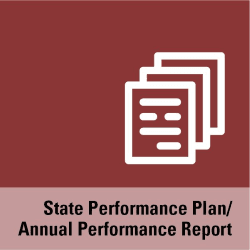About IDEA Part B and Part C SPP/APRs
The Monitoring and State Improvement Planning Division (MSIP) within the Office of Special Education Programs (OSEP) is responsible for ensuring States' compliance with the Individuals with Disabilities Education Act (IDEA). The IDEA requires States to submit annual reports, the State Performance Plan/Annual Performance Report (SPP/APR), which MSIP uses to ensure that States and other public agencies continue to implement programs designed to improve results for infants, toddlers, children, and youth with disabilities.
As required by IDEA, each State must have a SPP/APR that evaluates the State's efforts to implement the requirements and purposes of Part B and C of the IDEA, and reports annually to the Secretary on its performance under the Part B and C of the IDEA. Specifically, the State must report, in its SPP/APR, on its progress in meeting the measurable and rigorous targets it established.
The IDEA requires that the Department review the APR each year. Based on the information provided in the State's SPP/APR, information obtained through monitoring visits, and any other public information, the Department will determine if the State: “Meets Requirements” and purposes of the IDEA or “Needs Assistance,” “Needs Intervention,” or “Needs Substantial Intervention” in implementing the requirements of the IDEA.
The SPP/APR not only functions as a progress report for MSIP at the Department but also as a report for the State’s stakeholders. The SPP/APR is due in February of every year for the previous year's performance (the FFY 2018 APR is due in February 2020 and reports the school year 2018-19 performance).
